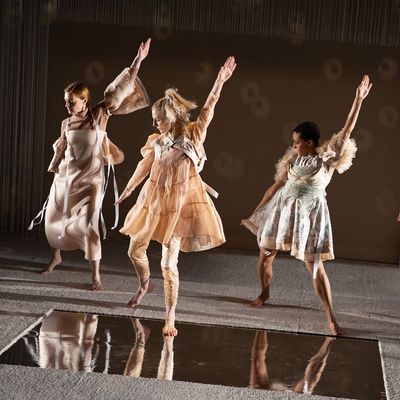
What premieres right after Thanksgiving? The audiences are still a little groggy, reeling from too much indulgence, trying to button themselves into sober workplace attitudes that were relaxed for a few days. Can they get it together to sit up straight? In two post-Thanksgiving shows, we see one shared answer to our carbohydrate-glutted attentions: Overwhelm them. Both The Mood Room and Candlelight feel like entering an altered state, oddly drugging experiences that pass through and over us like smoke. The Mood Room has a postprandial lassitude to it, a weird drowsiness that evaporates after the show. And Candlelight — well. If The Mood Room is some extremely mellow weed, then Candlelight is a tab of acid, given to you right before a job interview. I have tried to convince various people that I saw it, but every time I describe a portion of its plot, my listener accuses me of (a) lying or (b) taking anti-malarials.
In her program note for The Mood Room, the choreographer Annie-B Parson talks about why she was attracted to the plays of Guy de Cointet. An artist with roots both in Conceptual and Pop Art, de Cointet — who died in 1983 — had an interest in letters and codes that extended into a series of absurdist performance scripts. The last time I can find someone presenting one was a reconstruction at the Museum of Modern Art in 2012, in an exhibition about language and fine art. Parson, though, doesn’t pay much attention to category. She’s published a book in which she turned choreography into a mix-and-match card game; her Big Dance Theater is both a dance company and a theater company. So Guy’s work is usually found in museums? Doesn’t bother her a bit.
Parson’s cool-headed work as a movement-maker is more recognizable than ever before, its vocabulary globally familiar from David Byrne’s American Utopia. De Cointet, in a fake review of himself, said that his works “make alphabet soup of our cherished linguistic packaging.” This is a good explanation of what Parson does too. She takes simple movements (a slowed-down frug, a naïve step-touch, a gesture that says “here’s my wrist”) and cools and isolates them. Once we recognize them as her choreographic alphabet, she starts to stir them with increasing speed into her show.
In her note for the production at BAM, Parson explains that Cointet’s 1982 playlet Five Sisters underlies her The Mood Room, a desultory atmospheric that has as much talking as dancing and as much dancing as rolling around on a carpet looking lazy. She writes about Cointet’s texts as things “that bask in the hot mess of the non-narrative posing as narrative.” (Things happen; relationships exist; there is never anything so conventional as a plot.) Parson’s key verb there is bask. De Cointet spent time in Los Angeles, and a Pacific ennui pervades both the script and the experience. Watching The Mood Room is like being heat-dazed. Lauren Machen’s luxe, carpeted set is calming beige on beige, but the actual effect is like staring into the white-out of sun-dazzle. What is happening? Without noticing, your internal clock hops forward fifteen minutes, then seems to crawl backwards. Barely an hour long, the show takes an entire California afternoon.
That sense of an unending West Coast sunset is embedded in de Cointet’s sort-of story, in which five (maybe? They evince some doubt) sisters reunite a year after their parents’ deaths. Fragments of Chekhov’s Three Sisters show up in their speech, interpolated there by Parson. Dolly (Elizabeth DeMent) — her face fixed in an anxious frown — talks about her passion for work. Two of Dolly’s sisters (Michelle Sui and Kate Moran) worry for her, though they too can only talk about work and its bad opposite — strenuous leisure. All of them mention doctors they’re seeing for anti-aging treatments; Sui lolls on the set’s wall-to-wall carpet and meditates on vegetables, as if conversation is the same thing as living a healthy life. Every effort has been made for their comfort (even the books are bound in white fluffy fur), but the only true comfort comes from listening to Holly Herndon’s deliciously spacey electronic score.
The last two sisters are held in reserve, only emerging when the core three have exhausted the ways they are filling their time. A wonderfully wry and unimpressed Theda Hammel drops by for a moment; she can’t find her temporarily offstage sisters, so she marches a silent man through the set, complaining that he won’t leave his wife. (She makes him carry his shoes; clearly this guy will not be leaving a mark.) Then Myssi Robinson — one of the city’s most sparkling, vivid dancers — leaps and rolls onstage as the fifth sister, the one whose energy hasn’t yet been lost in West Coast ’80s gimme-culture fug. Eventually, though, she too slows and stops, overwhelmed by the other sisters’ inertia. Sui sings the word “beautiful,” and pink sunset light fades on their fancy, edgeless, beige nothing.
Even a few hours after The Mood Room, I was struggling to remember it. That’s not a knock on the show — it’s a tribute to its moody, eerie affect. It reflects that shut-in hermetic quality so familiar from just a few months ago, and a certain erasure of both time and memory were part of that lockdown experience. Machen’s lovely set includes a back wall made of many strings, with a “window” (actually one of Keith Skretch’s projections) high up on the left. In this bright rectangle, we see video images of the five sisters drifting slowly, as if physics applies differently in that upstairs space. This unreal reflection lets us see into the cloudlike and dreamy “mood room” itself, a place where the women can rest and ponder. The five sisters leave the stage occasionally, apparently on their way there, but they don’t go with any sense of gladness. As we think about the possibility of going back into isolation and shutdown, their velvety prison seemed suddenly familiar: soft clothes, soft books, soft rooms. Unbearable.
Now, Candlelight, on the other hand …
Even from the beginning, something seemed hinky. The playwright John Patrick Shanley — a big deal, with an Oscar for his screenplay of Moonstruck and a Pulitzer and a Tony for his play Doubt — had a world premiere debuting at the New Ohio Theater, a very small Off–Off Broadway venue. Bargain! I thought. As I sat down, though, I felt a sudden pang. I remembered that the most recent Shanley effort was the film Wild Mountain Thyme, and that movie (avoid the end of this sentence if you don’t want a spoiler) revolves around a man who thinks he is a bee. Still, I was not prepared for a fantasy-filled fever dream about a 10-year-old girl who discovers that she is the target of a supernatural murder plot, the object of her father’s lust, and an incarnation of the Virgin Mary. I continued to not be prepared through the show’s entire running time of 90 minutes, as the plot took wild hairpin turns, doubling back on itself, plunging into awful chasms that always seemed to include some kind of sexual assault.
Little Esperanza (Ivette Dumeng) is having a rough night. At her 10th-birthday party, she has glimpsed romance — sweet Tito (Marc Reign) tells her that being 10 is “the bomb” — but the shadow world seems to be turning against her. Esperanza’s mother has recently committed suicide, and now her left-behind bathrobe (wafted around by Darlene Tejeiro) is trying to talk her into jumping out the window, too. When the robe isn’t enticing her over to the windowsill, Esperanza is dodging her father, who emerges, nightmarishly, from her bed, wearing satyr’s horns and a giant red phallus. Luckily, she’s able to summon a friendly local squirrel, who hops in the window and bites the frothing father. Where does he bite him, you ask? What are you, new? In the nuts.
This is the end of just the first scene, and further ones will include a seminude fairy from Canada (Christina Toth) who dances during the transitions (“I went to Juilliard for three years for this?” she says); a demon that lives in a pot of oatmeal; the aforementioned visitation from Esperanza-as-Our-Lady, which is, relatively speaking, a throwaway; and a dance break. I think, though I cannot be sure of anything anymore, that Shanley is trying to tell a frightening story but filtering it through the eyes of a child. His key seems to be the terrified 10-year-old Paulie (John Cencio Burgos), whose embarrassment over his sexuality will lead him to betray the micro-Romeo and his micro-Juliet to her now-rabid father. But the careering production (directed by Lori Kee) can’t make sense of Shanley’s maniacal swings in tone. There’s something majestic, though, in how hard it steers right for the guardrails.
Recently, there has been quite a bit of online conversation about notions of “bad,” since the enjoyability of the Diana musical hinges on the watcher’s appetite for deliberately wackadoodle excess. I would not go so far as to say I enjoyed Candlelight, but I was certainly never ahead of its twists, and there is something bracing about an invention this crass and unguardedly bizarre. (I have enjoyed talking about Candlelight, and that’s not nothing.) Many of the things I prize about avant-garde theater are there inside it: shock, salaciousness, a blithe disregard for the conventional. Can you tell I have been trying to talk myself into liking it for almost a day now? I can’t quite do it, but maybe you can. The squirrel gets him in the nuts. C’mon! That has to be worth something.
The Mood Room is at BAM through December 5.
Candlelight is at the New Ohio Theatre through December 19.



